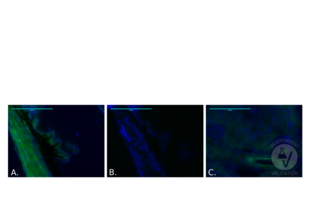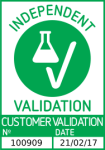CA12 antibody (AA 161-318)
Quick Overview for CA12 antibody (AA 161-318) (ABIN1858202)
Target
See all CA12 AntibodiesReactivity
Host
Clonality
Conjugate
Application
-
-
Binding Specificity
- AA 161-318
-
Purpose
- Polyclonal Antibody to Carbonic Anhydrase XII (CA12)
-
Specificity
- The antibody is a rabbit polyclonal antibody raised against CA12. It has been selected for its ability to recognize CA12 in immunohistochemical staining and western blotting.
-
Cross-Reactivity
- Human, Rat
-
Purification
- Antigen-specific affinity chromatography followed by Protein A affinity chromatography
-
Immunogen
- Recombinant Carbonic Anhydrase XII (CA12)
-
Isotype
- IgG
-
-
-
-
Application Notes
- Western blotting: 0.01-2 μg/mL,Immunohistochemistry: 5-20 μg/mL,Immunocytochemistry: 5-20 μg/mL,Optimal working dilutions must be determined by end user.
-
Comment
-
The thermal stability is described by the loss rate. The loss rate was determined by accelerated thermal degradation test, that is, incubate the protein at 37°C for 48h, and no obvious degradation and precipitation were observed. The loss rate is less than 5% within the expiration date under appropriate storage condition.
-
Restrictions
- For Research Use only
-
-
- by
- School of Clinical Sciences, University of Bristol
- No.
- #100909
- Date
- 02/21/2017
- Antigen
- CA12
- Lot Number
- A20170109527
- Method validated
- Immunohistochemistry
- Positive Control
- mouse kidney, mouse ciliary body
- Negative Control
- secondary antibody only
- Notes
- Primary Antibody
- ABIN3204699
- Secondary Antibody
- goat anti-rabbit IgG Alexa Fluor 488 antibody (Life Technology, A-11006, lot 1348202)
- Full Protocol
- Cryo-section:
- Wash mouse eye and kidney tissue in PBS.
- Cryo-protection. Suspend tissue in Optimum Cutting Temperature (OCT) embedding media (Thermo Scientific, Lot 03801137).
- Gently freeze suspended tissue in liquid nitrogen for 5min.
- Sections performed on a cryostat (LEICA, CM3050S) set to 12µm.
- Fix sections in 4% paraformaldehyde (PFA) for 5min at room temperature.
- Rinse sections in PBS 3 times for 5min.
- Block sections with 5% normal goat serum for 1h at RT.
- Immunostaining:
- Incubate sections with primary rabbit-anti CA12 antibody (antibodies-online, ABIN3204699, lot A20170109527) diluted 1:100 in PBSA, overnight at 4°C. Include a negative control without primary antibody and a kidney positive control.
- Rinse sections with PBS 3 times for 5min. Keep negative control in a separate jar.
- Incubate sections with secondary goat anti-rabbit IgG Alexa Fluor 488 antibody conjugate (Life Technology, A-11006, lot 1348202) diluted 1:500 in 1% Bovine Serum Albumin in PBS (PBSA) buffer for 2h at RT.
- Counterstain with DAPI in the mounting medium step.
- Wash and mount:
- Rinse sections in PBS 3 times for 5min.
- Mount sections in Vectorshield mounting medium with DAPI (Vector laboratories, H-1200, lot ZC0814).
- Microscopy:
- Image acquisition on an EVOS FL Color fluorescence and transmitted light microscope (Life technologies, Cat no. AMEFC4300) at 20x magnification.
- Experimental Notes
Validation #100909 (Immunohistochemistry)![Successfully validated 'Independent Validation' Badge]()
![Successfully validated 'Independent Validation' Badge]() Validation ImagesFull Methods
Validation ImagesFull Methods -
-
Format
- Liquid
-
Concentration
- 0.5 mg/mL
-
Buffer
- PBS, pH 7.4, containing 0.02 % Sodium azide, 50 % glycerol.
-
Preservative
- Sodium azide
-
Precaution of Use
- WARNING: Reagents contain sodium azide. Sodium azide is very toxic if ingested or inhaled. Avoid contact with skin, eyes, or clothing. Wear eye or face protection when handling. If skin or eye contact occurs, wash with copious amounts of water. If ingested or inhaled, contact a physician immediately. Sodium azide yields toxic hydrazoic acid under acidic conditions. Dilute azide-containing compounds in running water before discarding to avoid accumulation of potentially explosive deposits in lead or copper plumbing.
-
Handling Advice
- Avoid repeated freeze-thaw cycles.
-
Storage
- 4 °C,-20 °C
-
Storage Comment
- Store at 4°C for frequent use. Stored at -20°C in a manual defrost freezer for two year without detectable loss of activity. Avoid repeated freeze-thaw cycles.
-
Expiry Date
- 24 months
-
-
- CA12 (Carbonic Anhydrase 12 (CA12))
-
Alternative Name
- CA12
-
Background
- CA-XII, CAXII, Carbonate dehydratase XII, Tumor antigen HOM-RCC-3.1.3
Target
-


 (1 validation)
(1 validation)



